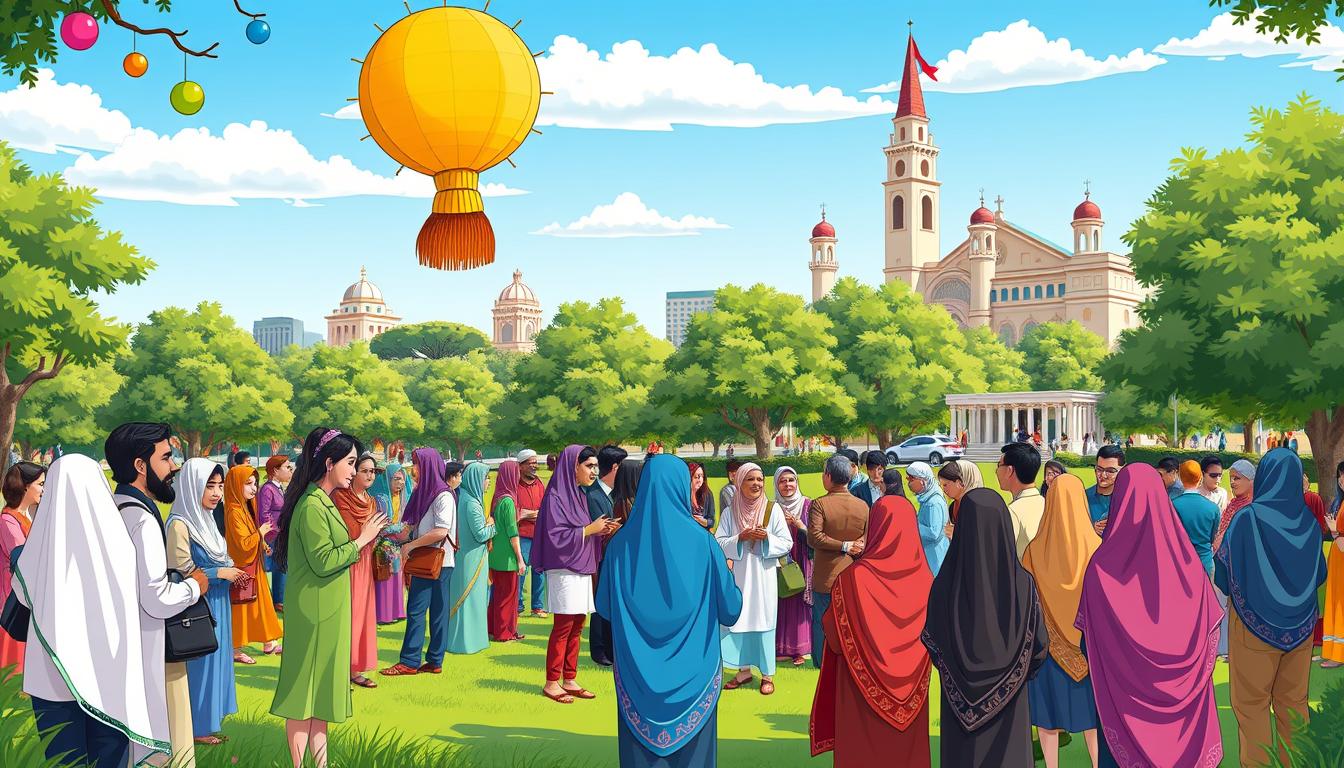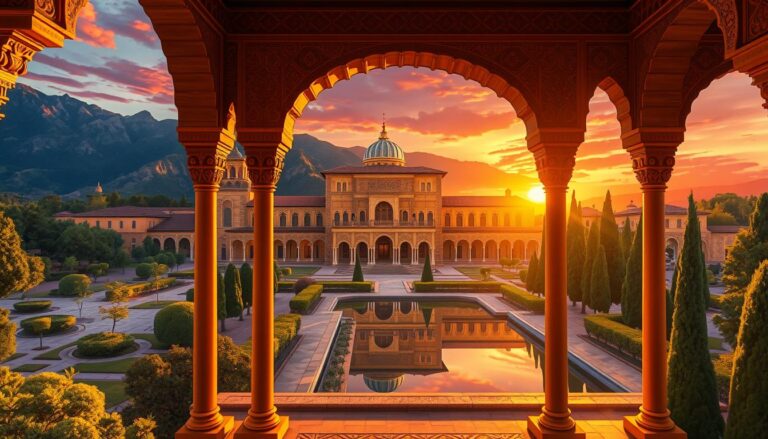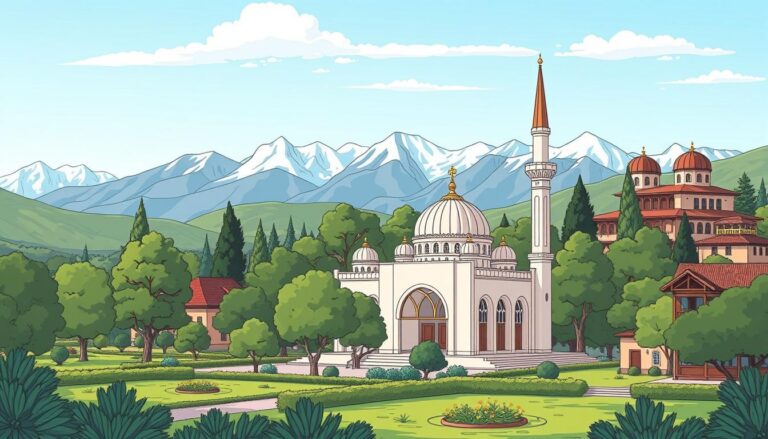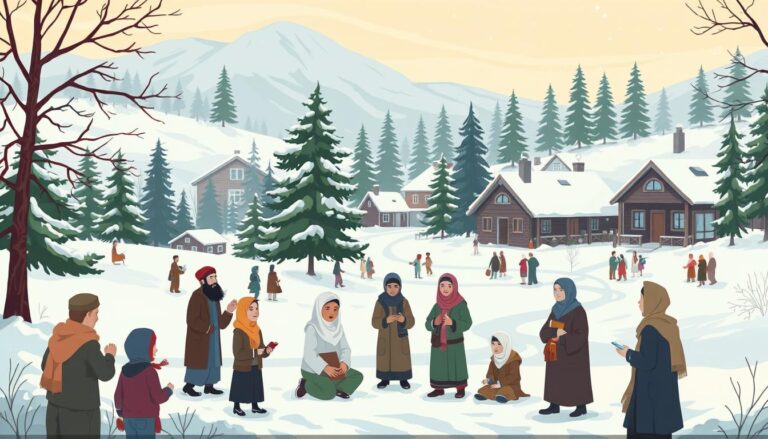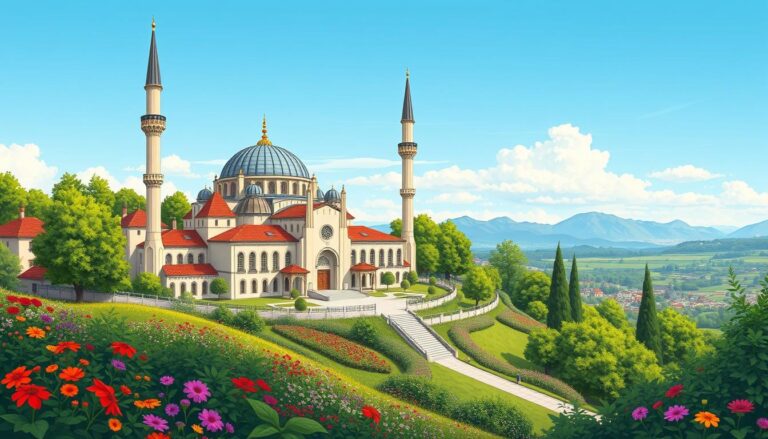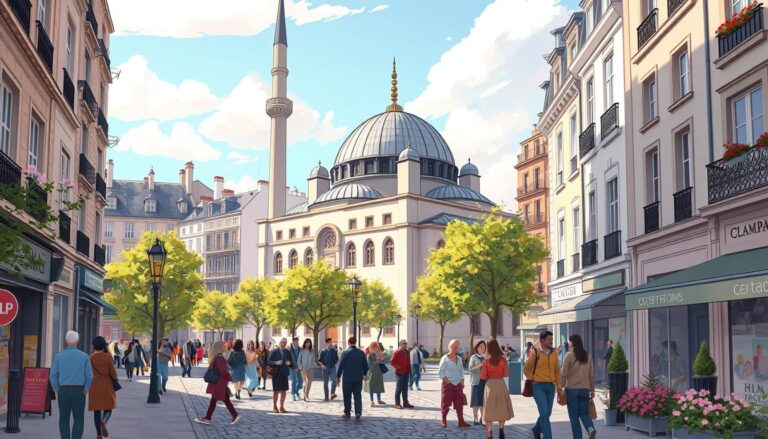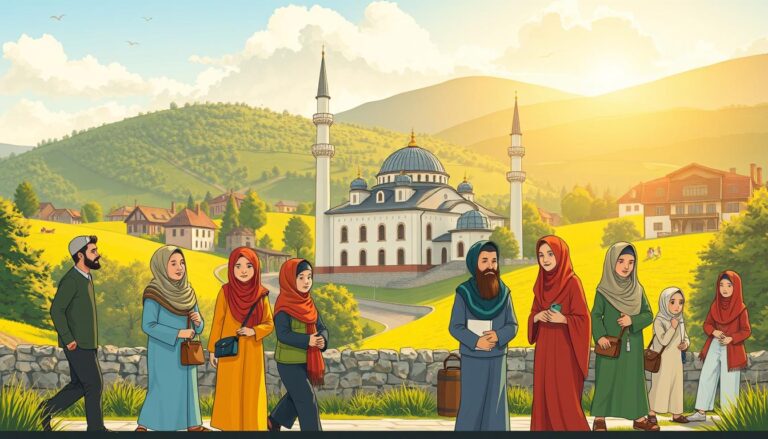Islam in Argentina
Argentina, a country renowned for its rich cultural diversity, is home to a surprisingly vibrant Muslim community. In fact, the Muslim population in Argentina is estimated to be around 1% of the total population, amounting to a staggering 400,000 to 500,000 members. This unexpected statistic underscores the significant presence of Islamic culture in this predominantly Christian nation.
Argentina’s religious landscape is marked by a long history of religious tolerance and diversity. While Roman Catholicism remains the largest denomination, accounting for up to 92% of the population, a wide array of other faiths, including Protestantism, Jehovah’s Witnesses, and The Church of Jesus Christ of Latter-day Saints, have also established a presence in the country.
Key Takeaways
- Argentina has a sizeable Muslim community, estimated at around 1% of the total population, or 400,000 to 500,000 members.
- The country has a long history of religious diversity and tolerance, with Roman Catholicism as the dominant faith but significant presence of other denominations.
- The first mosques in Buenos Aires were constructed in the 1980s, and the King Fahd Islamic Cultural Center, the largest mosque in Argentina, was inaugurated in 1996.
- The Islamic Organization of Latin America (IOLA), based in Argentina, is recognized as the most active organization in Latin America promoting Islamic affairs.
- Notable Argentine Muslims include former President Carlos Menem and Shaykh Isa Garcia, a scholar and translator of Islamic works.
Introduction
Islam has a rich and longstanding presence in Argentina, with the first Muslim settlers arriving during the Spanish exploration and conquest in the 15th century. Over the centuries, the country has seen significant waves of Arab immigration, particularly from Syria and Lebanon in the 19th century. Today, Argentina is known for its religious diversity and tolerance, providing a welcoming environment for the Muslim community to thrive.
Overview of Islam’s Presence in Argentina
The growth of Islam in Argentina dates back over 5 centuries, with some roots tracing back to a 9th-century Muslim Emirate. The country’s Muslim population is now estimated to be around 900,000 to 1 million, making up approximately 2% of the total population. The Muslim community in Argentina has experienced growth mainly in the nineteenth and twentieth centuries, with the arrival of immigrants from the Middle East and North Africa.
Argentina’s Religious Diversity and Tolerance
Argentina is renowned for its religious diversity and tolerance, providing a Halal-friendly environment for the Muslim community. The country’s laws protect against religious discrimination, and Muslims are free to practice their faith, wear Hijab, and access Halal-certified products. The King Fahad Islamic Center in Buenos Aires is the largest mosque in South America, serving as a hub for the local Muslim population.
Argentina’s openness to religious diversity extends beyond Islam, with a significant Jewish population, as well as the presence of other faiths. This inclusive atmosphere fosters cultural exchange and interfaith dialogue, enhancing mutual understanding and cooperation within the Argentine society.
Early Muslim Immigration to Argentina
The history of Islam in Argentina has deep roots, dating back to the era of Spanish exploration and conquest. The first documented Muslim settlers in the region were the Moorish-Morisco people, who fled persecution in Spain during the 15th century, such as the infamous Spanish Inquisition. These early arrivals left an indelible mark on the region’s cultural tapestry.
Moorish-Morisco Settlers and Spanish Exploration
The Moorish-Morisco settlers were not the only Muslim influence in Argentina’s formative years. The period between 1580 and 1640 in Buenos Aires also saw an active slave trade, with slaves arriving from Brazil via the Portuguese slave trade. Many of these slaves were of Muslim origin, further contributing to the history of Islam in Argentina.
19th-Century Syrian and Lebanese Immigration
The real influx of Arab immigration to Argentina, however, came in the 19th century, primarily from Syria and Lebanon. This wave of immigrants, many of whom were Muslims or descendants of Muslims, constituted the third most important immigration wave to the country. Between 1891 and 1920, approximately 367,348 people of Arabic heritage immigrated to Argentina, settling in various provinces across the nation.
Today, the Arab-Argentine community is estimated to account for around 7.6% of Argentina’s population, totaling over 3,500,000 individuals by ancestry. The majority of this community is of Lebanese or Syrian background, with significant populations also from Palestinian, Egyptian, and Moroccan origins.
Despite the strong Arab and Muslim presence in Argentina, the community has experienced a language shift, with Spanish becoming the predominant language, especially among younger generations. However, the legacy of the Moorish-Morisco settlers and the 19th-century Syrian and Lebanese immigrants continues to shape the rich cultural tapestry of Argentina.
Islamic Institutions in Argentina
Argentina’s Muslim community has a rich history and a growing presence across the country. In the heart of the capital city Buenos Aires, the country’s Muslim population has established several mosques and Islamic centers to serve their spiritual and cultural needs.
Mosques and Islamic Centers
The first mosques in Argentina were built in Buenos Aires in the 1980s. The At-Tauhid Mosque, opened in 1983, caters to the Shia Muslim community, while the Al Ahmad Mosque, opened in 1985, serves the Sunni Muslims. Today, there are mosques in several other cities, including two each in Córdoba and Mar del Plata, as well as the southernmost Sufi mosque in the world, located in El Bolsón.
The King Fahd Islamic Cultural Center
The King Fahd Islamic Cultural Center, the largest mosque in Argentina, was completed in 1996 with the help of the Custodian of the Two Holy Mosques, the then King of Saudi Arabia, Fahd. The project, which cost around US$30 million, includes a mosque, library, two schools, and a park. The Islamic center is also known as “La mezquita de Palermo” due to its location in the Palermo neighborhood of Buenos Aires.
“The King Fahd Islamic Cultural Center is a testament to the thriving Muslim community in Argentina and their commitment to preserving their faith and cultural heritage.”
The mosques in Argentina and the Islamic centers play a vital role in the lives of the country’s Muslim population, serving as hubs for worship, education, and community gatherings. These institutions not only cater to the spiritual needs of the faithful but also contribute to the cultural diversity and understanding in Argentina.
Islamic Organizations and Activities
Argentina’s Islamic community has a vibrant and active presence, with various organizations playing a vital role in promoting and preserving Islamic heritage in the country. One of the most prominent organizations is the Islamic Organization of Latin America (IOLA), which is headquartered in Argentina.
The IOLA is considered the most active organization in Latin America in promoting Islamic-affiliated endeavors. The organization holds events and activities aimed at unifying Muslim communities across Latin America and fostering the propagation of Islam in the region. With a focus on cultural exchange and educational initiatives, the IOLA has been instrumental in strengthening the ties between Argentina’s Muslim population and the broader Islamic world.
“The Islamic Organization of Latin America (IOLA) is the most active organization in Latin America promoting Islamic-affiliated endeavors, unification of Muslims in Latin America, and the propagation of Islam.”
In addition to the IOLA, other Islamic organizations in Argentina, such as the Islamic Organization of Latin America and the Caribbean (OIPALC), have also been active in the region. These organizations have facilitated programs and initiatives that bring together Muslims from across the Americas, fostering cross-cultural understanding and promoting the integration of the Islamic faith into the diverse social fabric of Argentina.
The vibrant activities and initiatives of these Islamic organizations have played a crucial role in shaping the dynamic landscape of Islam in Argentina, contributing to the country’s religious diversity and promoting interfaith dialogue and cooperation.
Islam in Argentina
While precise statistics on religious affiliations in Argentina are not readily available, the Muslim community is estimated to make up around 1% of the country’s total population, or between 400,000 to 500,000 members. Despite being a minority, Argentine Muslims have integrated well into society and have made significant contributions in various fields, such as business, politics, and academia.
Estimated Muslim Population
Argentina is home to the largest Muslim community in South America, with an estimated population of approximately 900,000 to 1 million, making up about 2% of the total population of the country. The Muslim community in Argentina mainly comprises Arab natives, with roots dating back five centuries, and some members tracing their origins to a 9th-century Muslim Emirate.
Integration and Contributions
- The King Fahad Islamic Center, built in Buenos Aires in 1996, is the largest mosque in South America and serves as a center for Islamic education with a library and two Islamic schools.
- Halal meat is readily available in Argentina, a country renowned for its high-quality and flavorful steak, contributing up to 7% of the world’s meat supply, with many Muslim countries being major importers of Argentinian meat.
- Former Argentinian President Carlos Menem, who was born to Syrian Muslim parents, converted to Catholicism later in life but remained connected to the Muslim community, exemplified by his contributions towards building the King Fahad Mosque.
- Argentina passed legislation in 2011 specifically aimed at protecting Muslims from discrimination, providing a safe environment for them to practice their faith, work, study, engage in sports, and have official identification photos while adhering to Islamic customs such as wearing the hijab.
The integration and contributions of the Muslim population in Argentina showcase the country’s religious diversity and tolerance, making it a welcoming home for people of various faiths.
https://www.youtube.com/watch?v=U5mR56HkJOg
Notable Argentine Muslims
Argentina, known for its diverse religious landscape, has produced several notable Muslim figures who have made significant contributions to the country’s social and political spheres. Among them are Carlos Menem, the former President of Argentina, and Isa Garcia, a respected scholar and translator of Islamic studies.
Carlos Menem, Former President
Carlos Menem, a convert to Islam, served as the President of Argentina from 1989 to 1999. During his tenure, he implemented fiscally conservative, market-oriented economic policies that led to economic stabilization, but his presidency also faced challenges such as internal party feuding and corruption.
Menem’s Islamic faith was a point of interest during his political career. He initially maintained his Muslim identity, but later converted to Roman Catholicism to align with the official religion of Argentina in pursuit of his political aspirations. Despite this, Menem’s Muslim background and his sale of land to build the King Fahd Mosque, the largest mosque in Latin America, cemented his legacy as a notable Argentine Muslim.
Isa Garcia, Scholar and Translator
Isa Garcia, born in Buenos Aires, is a specialist in the origins of Prophetic Tradition and has translated numerous books on Islamic studies, making them available to Spanish-speaking readers. Garcia is also listed as one of the top 500 Most Influential Muslims in the World, highlighting his significant contributions to the dissemination of Islamic knowledge and scholarship.
The presence of these prominent Argentine Muslims, such as Menem and Garcia, demonstrates the diversity and integration of the Muslim community within the country’s social and cultural fabric. Their achievements and influence have played a vital role in shaping the discourse around Islam in Argentina.
Challenges and Opportunities
As a minority religion in Argentina, the Muslim community faces certain challenges in maintaining their cultural and religious identity while integrating into the broader society. However, the country’s tradition of religious diversity and tolerance also presents opportunities for the Muslim community to thrive and contribute to the country’s social and cultural fabric.
One of the key challenges facing Islam in Argentina is the influence of Islamic fundamentalism and the associated concerns about terrorist activities in the region. According to recent studies, there is a notable presence of Islamic fundamentalism in Latin America and the Caribbean, which has raised concerns about the potential for terrorist threats.
The Muslim population in Argentina, though relatively small, plays a significant role in the context of these concerns. The country has seen an increase in religious practice, with more than 43% of the population attending church at least once a month. This highlights the importance of fostering understanding and cooperation between the Muslim community and the broader population.
Despite these challenges, the Muslim community in Argentina has also seen opportunities to strengthen its presence and contribute to the country’s diversity. The construction of the largest mosque in South America in Buenos Aires in 1998 has been a significant milestone, and the Islamic community has gained better organization and visibility.
Moreover, the growing presence of immigrants from various regions, including Africa, has contributed to the expanding Muslim population in Argentina. This diversity can be seen as an opportunity for cultural exchange and interfaith dialogue, which can help to promote mutual understanding and social cohesion.
“The challenges facing Islam in Argentina are not insurmountable, and the country’s tradition of religious tolerance presents opportunities for the Muslim community to thrive and contribute to the nation’s rich cultural tapestry.”
As Argentina continues to navigate the complexities of religious diversity, addressing the challenges and seizing the opportunities will be crucial for the integration and success of the Muslim community within the country.
Cultural Exchange and Interfaith Dialogue
Argentina’s religious diversity has fostered a climate of cultural exchange and interfaith dialogue between Muslims and non-Muslims in the country. The Muslim community has actively participated in initiatives to promote understanding and cooperation among various faith groups, strengthening the social fabric and creating a more inclusive society.
According to a 2019 survey by Conicet, the Catholic population accounts for 62.9% of Argentina’s population, while 15.3% identify as Protestant, and 18.9% have no religious affiliation. The Muslim community, while a smaller percentage, is estimated to be between 800,000 to 1,000,000 strong, with the country also hosting one of the largest Jewish communities in Latin America.
Fostering Understanding and Cooperation
The Islamic community in Argentina is actively engaged in promoting interfaith dialogue and cultural exchange through organizations like the Islamic Cultural Center of Argentina and the Islamic Organization for Latin America and the Caribbean. These initiatives have facilitated events, activities, and seminars that bring together religious leaders, scholars, and community members from diverse faiths, including Judaism, Catholicism, Evangelism, and Islam.
Recent events, such as the signing of the “Declaration of Latin America and the Caribbean as an Interreligious Coexistence Zone” in Córdoba, have demonstrated the commitment of religious leaders to building bridges and fostering understanding across faith communities. The Vatican under Pope Francis I has also actively supported these efforts, showcasing a dedication to strengthening ties between different faiths.
Through these sustained efforts, the cultural exchange between Muslims and non-Muslims in Argentina has become an integral part of the country’s social fabric, contributing to a more inclusive and harmonious society.
Future Prospects for Islam in Argentina
As the Muslim community in Argentina continues to grow, the future prospects for Islam in the country appear promising. The strong foundation of Islamic institutions and the active involvement of the Muslim population have helped solidify their place as a valued minority faith within the diverse religious landscape of Argentina.
According to global demographic trends, the Muslim population is expected to increase by around 35% in the next 20 years, rising from 1.6 billion in 2010 to 2.2 billion by 2030. This growth is projected to be particularly evident in the Asia-Pacific region, where nearly three-in-ten people are expected to be Muslim by 2030.
While the Muslim population in Argentina currently stands at an estimated 1-2% of the total population, the country has historically been a welcoming destination for Muslim immigrants, particularly from the Middle East and North Africa. The presence of prominent Islamic institutions, such as the Central Mosque and the King Fahd Islamic Culture Centre, further strengthens the foundation for the future growth and integration of the Muslim community in Argentina.
However, the future of Islam in Argentina is not without its challenges. Factors such as the loss of cultural customs, a lack of Spanish-language resources on Islamic teachings, and a decline in the establishment of study centers for Islamic education may pose obstacles to the intergenerational transmission of the faith. Nonetheless, the relative absence of anti-Islamic rhetoric and racial isolation experienced by Muslim minorities in Argentina, compared to some Western countries, suggests a more favorable environment for the continued integration and acceptance of the Muslim community.
As the global Muslim population continues to evolve, the prospects for the future of Islam in Argentina remain optimistic. With ongoing efforts to foster cultural exchange, interfaith dialogue, and the active participation of the Muslim community in the social, economic, and political fabric of the country, the growth of the Muslim community in Argentina is expected to solidify their presence and contributions in the years to come.
“In countries like Germany, Muslims faced challenges in distributing copies of the Quran to German families, indicating resistance to Islamic influence in some Western societies.”
Conclusion
Islam has a long and vibrant history in Argentina, with the Muslim community playing a significant role in the country’s religious diversity and cultural landscape. Despite being a minority, Argentine Muslims have made important contributions in various spheres and continue to thrive, fostering understanding and cooperation with their fellow citizens. The United Nations Assembly declaration of the “Elimination of All Forms of Intolerance and of Discrimination Based on Religion or Belief” on November 25, 1981, underscores Argentina’s commitment to religious tolerance and pluralism.
As the followers of Islam in Argentina represent more than 70 branches, each interpreting the faith differently, the community has embraced the true message of Islam, which introduced gender equality 14 centuries ago and established the separation of state and religion in a pluralistic society. The Ahmadiyya Muslim Community in Argentina, for instance, follows the motto “Love for all, Hatred for none,” promoting interfaith dialogue and cultural exchange.
Looking to the future, the prospects for Islam in Argentina appear bright. With initiatives like the free Arabic and Islam classes that have attracted hundreds of Argentinians, the Muslim community is actively sharing the true message of their faith and welcoming new converts. As Argentina’s religious landscape continues to evolve, the integration and contributions of the Muslim community will undoubtedly play a crucial role in shaping the country’s diverse and inclusive future.
Source Links
- Islam in Argentina
- Religion in Argentina
- Islamic facts about Argentina | IslamicFinder
- Islam in Argentina
- ISIM-Newsletter-06
- Arab Argentines
- Argentina – United States Department of State
- King Fahd Islamic Cultural Center
- Islam In Argentina [by : wikipedia]
- Islamic Organization of Latin America
- Argentina – United States Department of State
- Argentina’s Muslim Minority
- Carlos Menem | Biography & Facts
- Argentina
- Argentina – United States Department of State
- Exploring Different Religions in Argentina: A Comprehensive Guide
- A toast to interfaith dialogue in Latin America – World Jewish Congress
- The Future of the Global Muslim Population
- Islam and Muslims in Argentina
- Opportunities and threats of Muslim minorities in the world – The Institute for Islamic World Futures Studies
- Islam: a guardian or a threat to religious freedom?
- Islam in Argentina: Arabic classes, Islam and coffee shops

